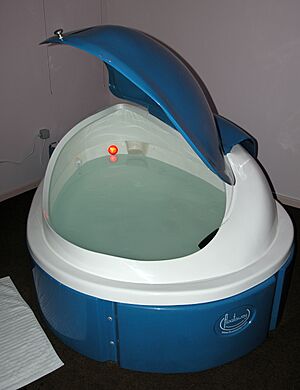Sensory deprivation facts for kids
Sensory deprivation happens when a person cannot use one or more of their senses. This means they might not be able to see, hear, smell, touch, or taste things. It can also affect their sense of thermoception (feeling heat or cold) and their sense of gravity (knowing which way is up or down).
Devices for sensory deprivation can be very simple. For example, a blindfold or a hood can stop someone from seeing. More complex devices can block out sounds, smells, touch, and even the feeling of gravity.
Contents
What is Sensory Deprivation?
Sensory deprivation is when you limit or remove the information your senses usually get. Imagine being in a quiet, dark room where you can't see, hear, or feel much. This is a form of sensory deprivation. It can be done for short times or longer periods.
How Sensory Deprivation Can Be Used
Sensory deprivation can be used in different ways, some good and some not so good.
Good Uses of Sensory Deprivation
If a person chooses to experience sensory deprivation for a short time, it can be very helpful.
- Relaxation: Many people find it helps them feel very relaxed.
- Meditation: It can make it easier to meditate and focus their thoughts.
- Therapy: Some people use it to reduce stress or to help with certain health conditions. For example, flotation tanks (like the one in the picture) are often used for this. They let you float in salty water in a dark, quiet space.
Bad Uses of Sensory Deprivation
However, if someone is forced into sensory deprivation, or if it lasts for a very long time, it can be harmful.
- Hallucinations: People might start to see or hear things that aren't there. These are called hallucinations.
- Anxiety and Depression: It can cause strong feelings of anxiety (worry) and depression (sadness).
- Strange Thoughts: People might also start to have unusual or confusing thoughts.
Some countries have used sensory deprivation techniques when questioning prisoners. This is done to try and get information from them.
See also
In Spanish: Privación sensorial para niños


